Most of the books and magazines in our collections, and those in many other libraries – particularly for non-fiction – are arranged by the Dewey Decimal Classification system. First published in 1876, this numerical system for organising knowledge has been republished 23 times. Ongoing revisions continue and OCLC, the organisation that manages Dewey, are inviting contributions to make Dewey more global and inclusive in the way it classifies material in library collections.
As staff working with the collections, we are very fortunate to spend time in the stacks, browsing the shelves. It can be difficult to imagine from a catalogue record, what may arrive when you submit a request for a book. As you can see from the snapshots below – it varies greatly!
In exploring some of the titles below, to share some recipes – I discovered that May Byron was a prolific author and poet, as well as producing a selection of recipe books – including the just republished: The Great War cook book: From trench pudding to carrot marmalade.
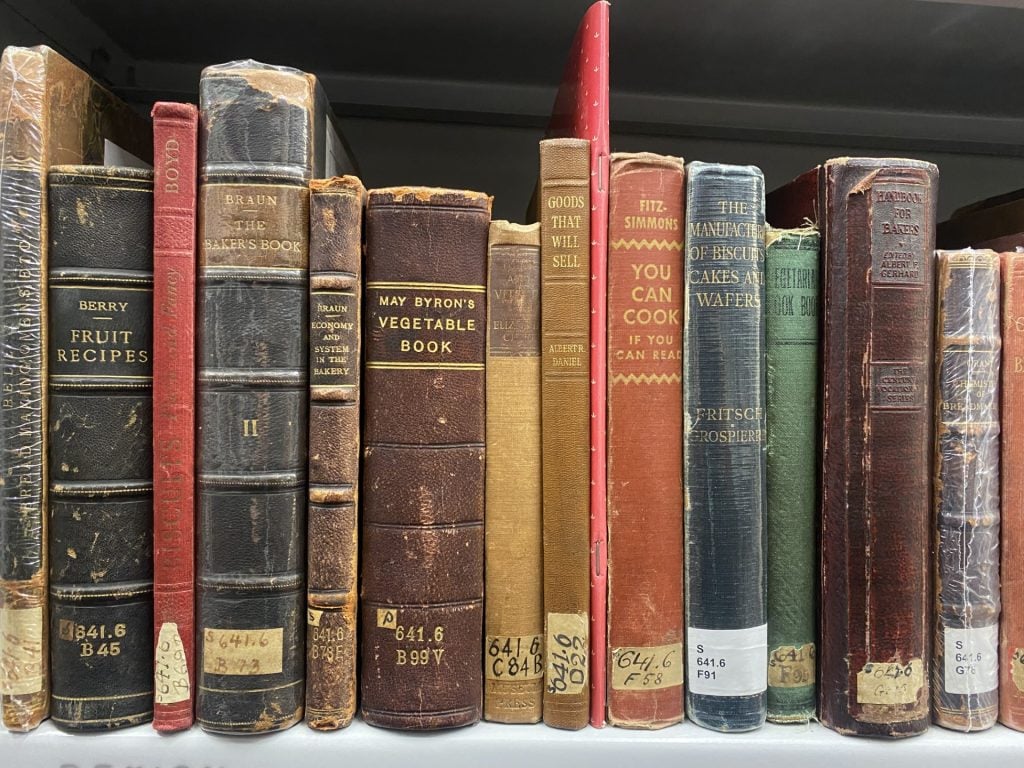
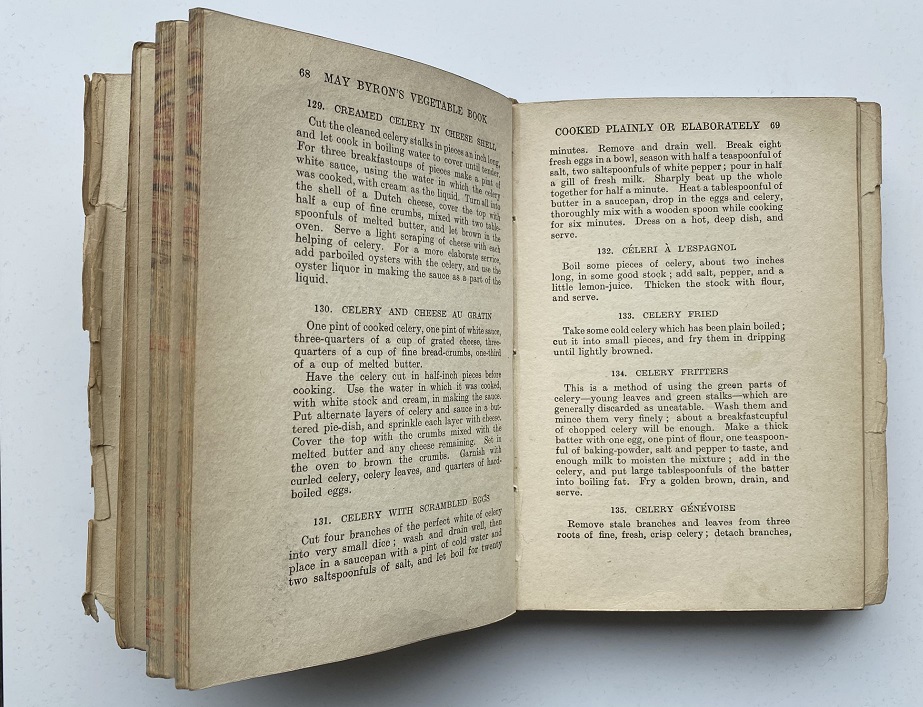
Byron’s Vegetable book, first published in 1916, surveys the history of vegetables for the table:
Our ancestors of the Middle Ages – such as were well to do – did not – indeed take much notice of vegetables, except as salads… the Elizabethans expended their ingenuity and their appetite upon fish, flesh and fowl… meanwhile the poor folk made shift to eke out their scanty meals with any sort of green stuff. During the nineteenth century they reached perhaps their maximum of variety…[today] the list available in the greengrocers shop… is quite extraordinary in its limitations… on the Continent and in the United States a much wider range is proffered. 1
Continental European cookery was first published in Poland in 1934, and again in 1947. Many of our current concerns about the relationship between food and health are set out in the foreword:
… the importance of food as an indispensable factor to the health of mankind is very often underrated… Cookery is in danger to become the cookery of a mechanised civilisation and the desire to save time and economise the efforts of the housewife, limits the preparation of food to the reheating and seasoning of manufactured products… it can be explained but not justified. 2
The book includes a rich array of recipes, with short ingredient lists and succinct instructions.
A bright yellow cover encloses Maria Kozslik Donovan’s Continental cookery in Australia, first published in 1955. This book, and her later work, The Far Eastern epicure: a culinary journey to the Far East with original recipes and drawings, were among a number of early books to introduce more varied culinary traditions to Australia.
Donovan arrived with her family in Melbourne in 1953. She ran a cookery school and published a weekly cookery column in The Age, before departing for Italy in 1961. 3 Epicures’ corner included a weekly recipe and some background for the dish – from Linzer torte to filets de poisson a la meuniere. The snapshot below shows some more of the variety of culinary traditions included in our collections.
The spines also display the multiple generations of labelling in evidence – the handwritten, and typed, and unorthodox spine relabelling as well – as is the case on Foods of the foreign-born. This caught my eye, but the content wasn’t what I expected. Published in 1922, Bertha M Woods, a dietitian, published widely on the importance of good nutrition and its role in health, and how best to maximise those opportunities, particularly in relation to migrant communities:
There is much we may learn from these people and, equally much for them to learn from us with profit. A dietitian has never been so honored, in college or out, as she will be by these foreign-born people when once she talks to them of their familiar foods.4
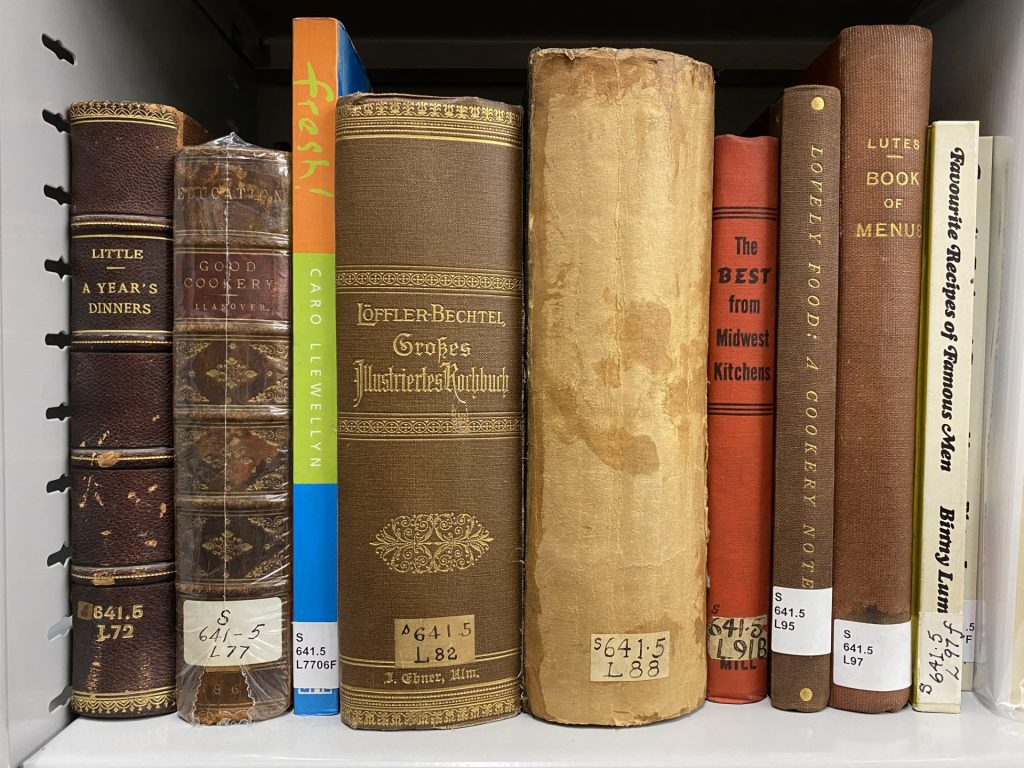
Published in numerous reprints since 1848, Henriette Loffler, later joined by Theodor Bechtel produced this comprehensive tome (below) with over 3,500 recipes. Written in paragraph style, with the ingredients incorporated into the method, and printed in traditional German script, the book includes the full array of foodstuffs, with illustrations in both colour and black and white.
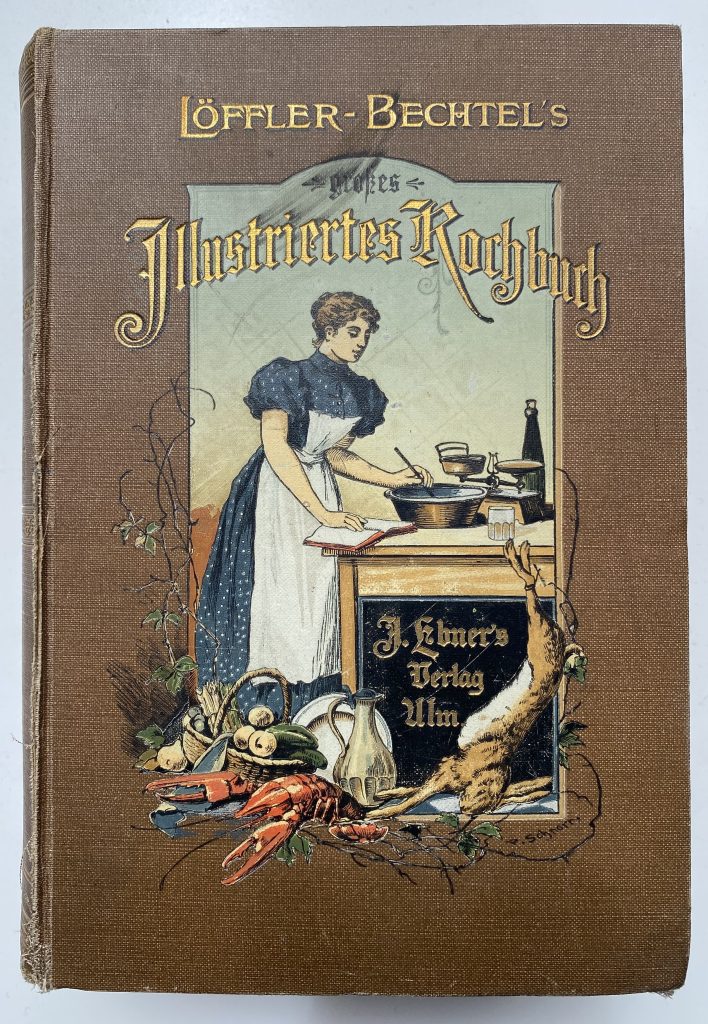
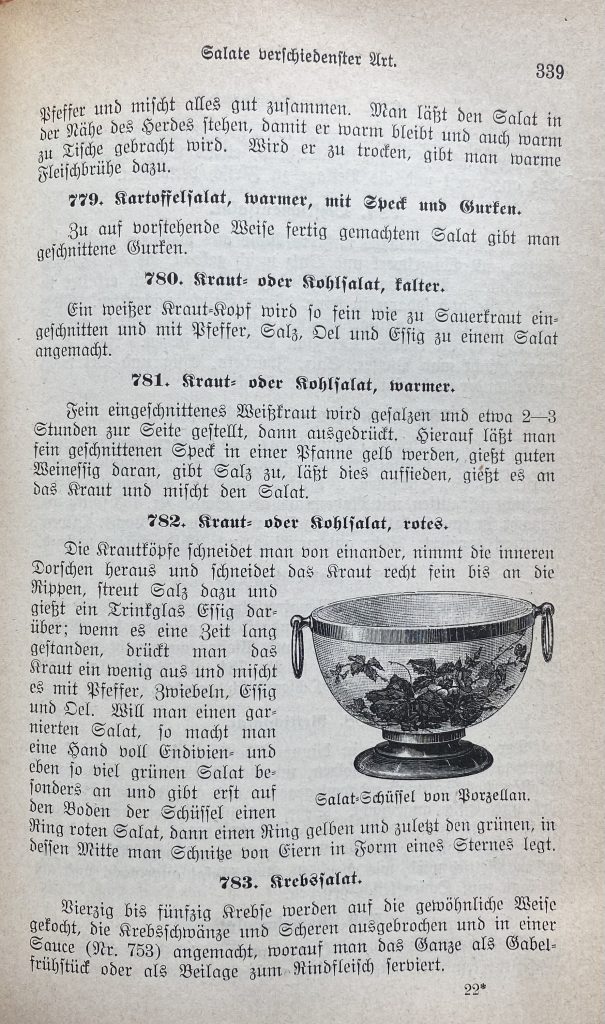
This small volume (below) took my eye and upon closer examination, I found it was published in the year the then Melbourne Public library opened.

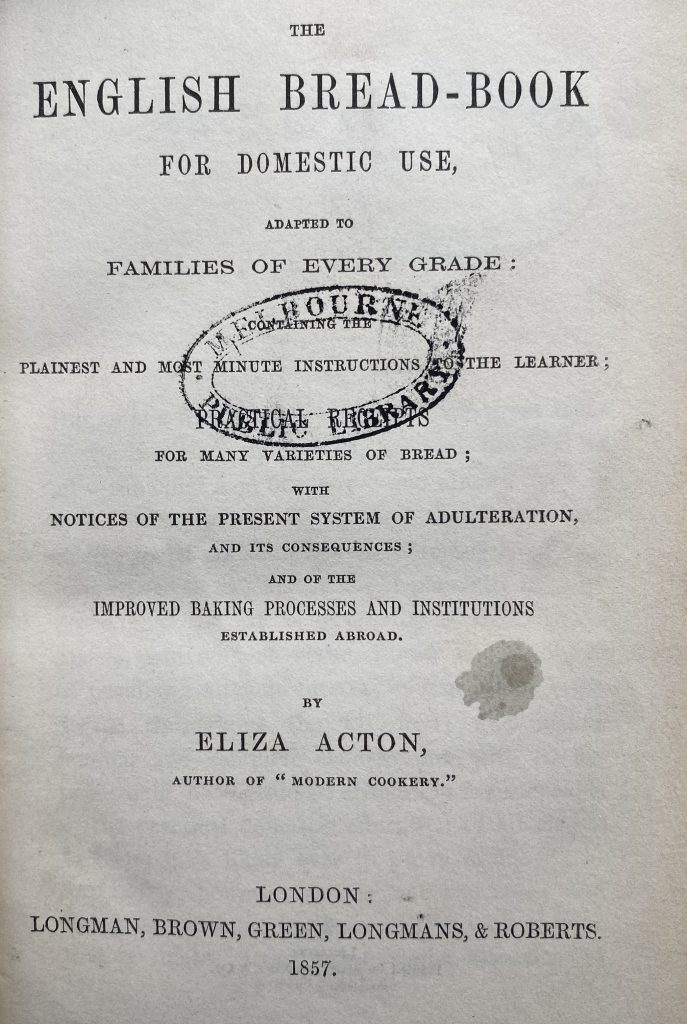

Eliza Acton published her Modern cookery, in all its branches: reduced to a system of easy practice, for the use of private families in 1845. Dedicated to ‘the young housekeepers of England’, her opening sentence informed her readers of the aim of the book:
The proper and wholesome preparation of our daily food, though it may hold in the estimation of the world but a very humble place among the useful arts of life, can scarcely be considered an altogether unimportant one, involving so entirely, as it does, both health and comfort.5
Acton notes the previous resistance to ‘innovations in general… and of strangers in particular… happily for ourselves we have ceased to be too bigoted, or too proud to profit by the superior information and experience of others.’6
Expanding on the chapter on bread, The English bread-book, published in 1857, was a thorough exploration of flours and bread production that sought to encourage home baking and warned of the ‘systems of adulteration and its consequences’. The quantities of bread baked are alarming – a peck, the unit of measurement here – is approximately 9 litres of volume.

Henrietta C. McGowan published her Keeyuga cookery book in 1911, writing to encourage independence and healthy and economical eating. She gave suggestions for example, on how to set up to cook as a single person in rooms, listing these essential pantry items: self raising flour in a 4 lb tin, Cerebos salt, a jar of coarser salt, a tin of tea, a tin of pepper, a bottle of vinegar, a bottle of Mildura olive oil, a tin of coffee, a 2 lb tin of rice, and a small tin of curry. 7

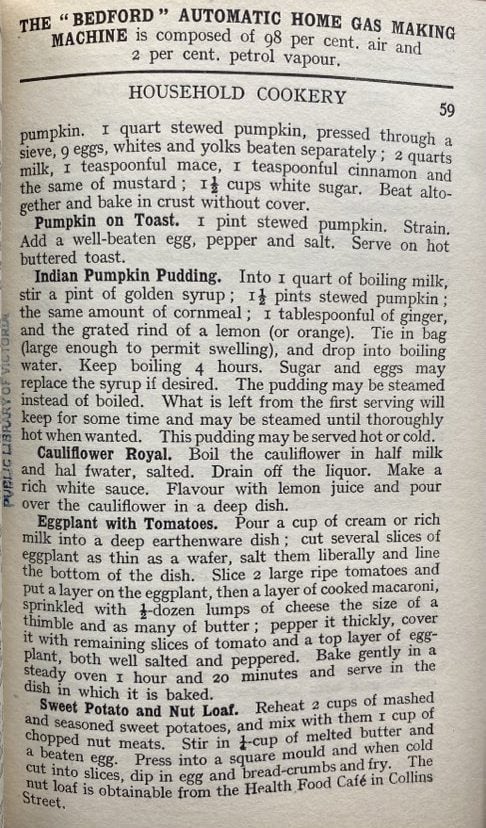
Another concern for McGowan was how women could support themselves, and the book included recipes for women who might make a living from cooking. ‘We now come to a class that has been kept well in mind while this book was being written – the class made up of women who sell foodstuffs for a living.’ 8 Success here meant there was always a good living at her fingertips.
Together with Margaret Cuthbertson, McGowan published Woman’s work: a guide to the nature, terms and conditions of many kinds of work for women.
The shelf below includes some more contemporary books – with Kylie Kwong and Poh Ling Yeow – alongside the Gentle art of cookery, by Hilda Leyel and Olga Hartley and the Kookaburra cookery book compiled by the Lady Victoria Buxton Girls’ Club.
Leyel and Hartley encouraged shopping and cooking with the seasons, embracing vegetables and treating them more respectfully than just boiling them. They saw this more proper treatment as ‘the guiding line between good and indifferent cooking’.9. The book, with recipes, was often written as prose and counted on a familiarity with methods and flavouring. It was ‘not intended to be an elementary handbook on cookery’ but had been ‘written for those who appreciate the fact that good cooking is one of the attainable amenities of life if extravagance is eliminated’. 10 Leyel went on to found the Herb Society in 1927.
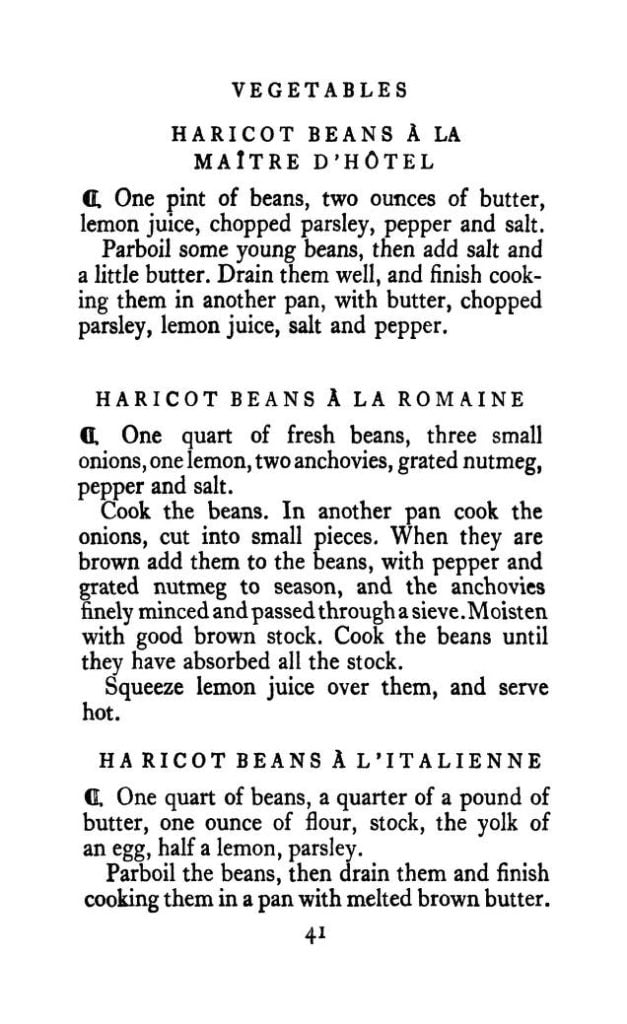
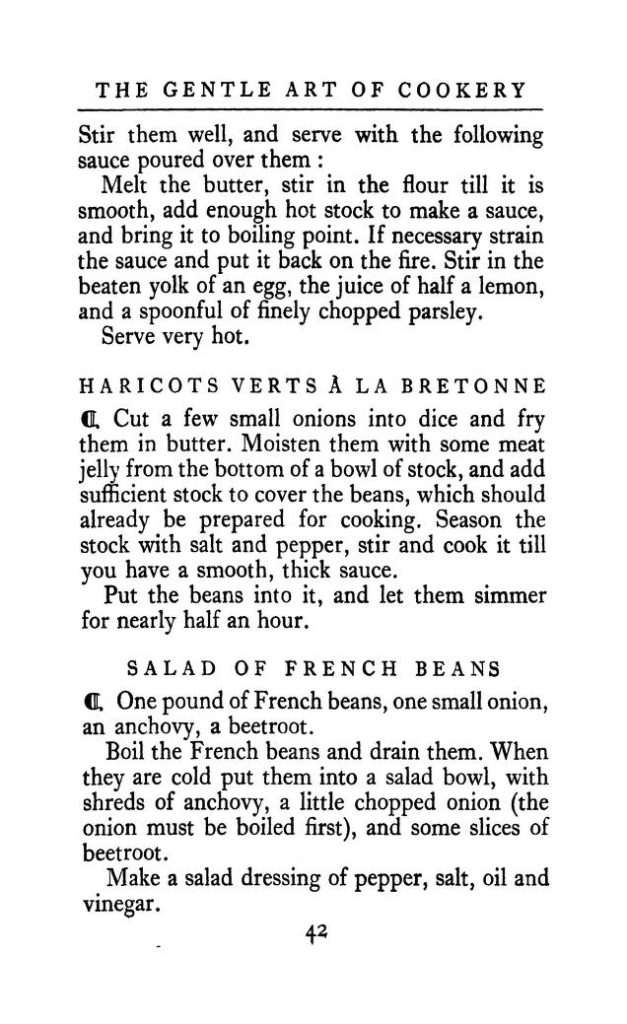

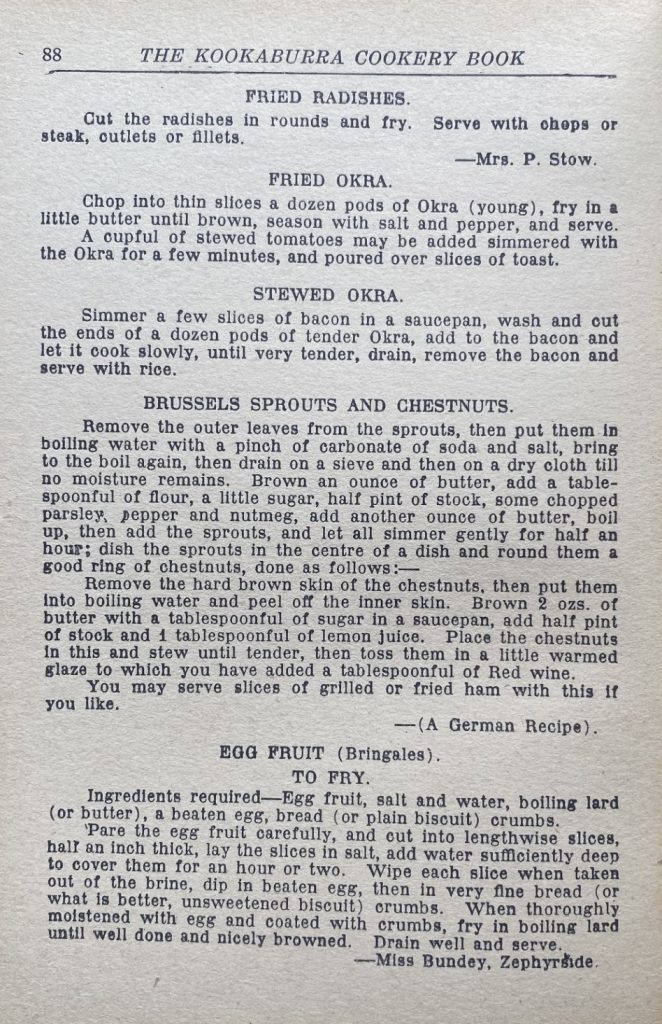
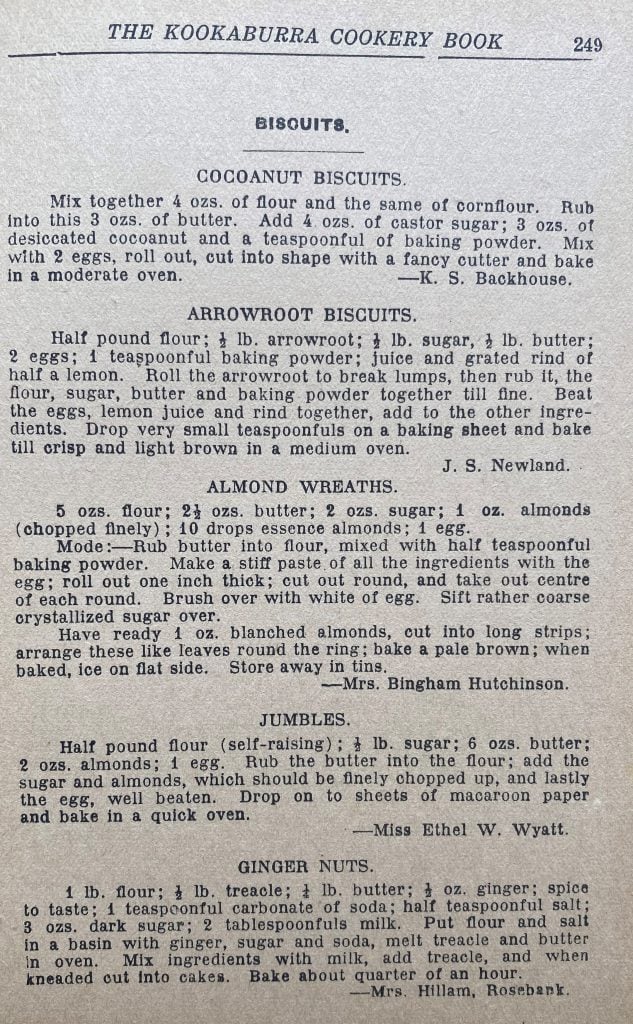
The Lady Victoria Buxton’s Girls’ Club was founded by Lady Victoria, wife of the South Australian governor in 1898. The Kookaburra cookery book (above), a compilation of recipes, was produced as a fundraising effort to improve facilities at the hostel. This copy is inscribed with birthday greetings to Miss Westerman from her colleagues at Yarram School, 2 February 1945.
This is just a tiny glimpse of the richness on offer at 641.5 and beyond – you can visit the same number on our open access shelves in the Redmond Barry Reading Room and the La Trobe Reading Room, or visit your local public library to discover more. The diversity in culinary offers has broadened markedly over the years, and our collections now include recipe books from Turkey, China, India, Thailand, Italy the Middle East and more.
References
- Byron, M, 1916, May Byron’s vegetable book: containing over 750 recipes for the cooking and preparation of vegetables, Hodder and Stoughton, London, UK, p 3
- Disslowa, M, 1952, Continental European cooking: practical cooking guide (realised and adapted by J W Rybotycka; E. A. Martin trans) [5th ed], Tern, London, pp 9-10
- Brien, D L, 2013, ‘The cookbooks of Maria Kozslik Donovan’, TEXT 17 (Special 24), p 1–7, viewed 12 December 2023, doi: https://doi.org/10.52086/001c.28283
- Woods, Bertha M, 1922, The foods of foreign-born in relation to their health, Whitcomb & Barrows, Boston, p viii
- Acton, Eliza, 1849, Modern cookery, in all its branches: reduced to a system of easy practice, for the use of private families, Longman, Brown, Green and Longman, London, p vii
- As above, p vii
- McGowan, Henrietta C, Keeyuga cookery book Keeyuga cookery book, 1911, Lothian, Melbourne, p 7
- As above, p 2
- Leyel, C F and Hartley, Olga, 1935, The gentle art of cookery, Chatto and Windus, London, p 31
- As above, p vi


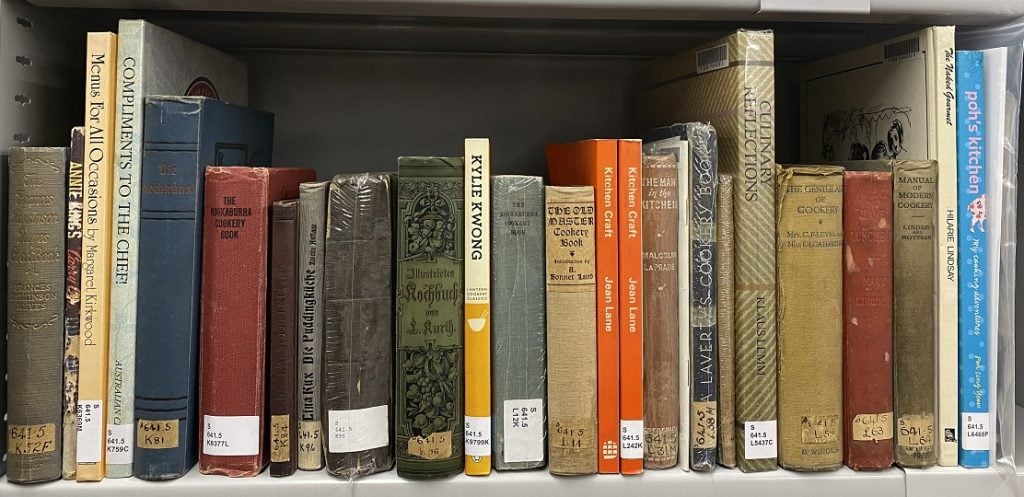

Fascinating introduction to the wide range of early non Australian cookbooks.
Hello Amanda – many thanks for reading and your comment too – glad you enjoyed the blog, it is a wonderful collection to explore.
Hi Jane, this is fascinating and very interesting.
I noticed Caro Llewellyn’s book. I have just emailed her the link to this.she will be pleased.
I wonder if you also have a copy of my book. It is out of print. There were two editions.
It is called Sicilian Seafood Cooking.
Hello Marisa – thank you! I’m glad that you enjoyed reading the post – it was hard choosing the material to include. No we don’t have your book – it is held in 6 public libraries in Victoria, plus the legal deposit copies in the national Library and State Library of NSW – here is the listing for libraries around Australia. Happy cooking!
Thanks Jane.
A pleasure Marisa!
Hi Jane, this is fascinating and very interesting.
I noticed Caro Llewellyn’s book. I have just emailed her the link to this….she will be pleased.
I wonder if you also have a copy of my book?It is out of print. There were two editions.
It is called Sicilian Seafood Cooking.
Thank you.
Loved reading this Jane, especially the section on Maria Kozslik Donovan (and the links to all her recipe columns in Epicure in the Age – I plan to read them all!). Loved the glimpse at all the lovely spines too.
Hello Saskia – many thanks – I still have my mothers copy of Continental cookery in Australia – and reading the newspaper columns does take you back too. Doing the photographs for the blog was a lovely thing to work on as well as the words.
A wonderful cookery book collection! I love the recipe on Good Family Bread from The English bread-book.
The mention of a peck as a unit of measure reminds me of being with my family in Maine and seeing fruit and vegetables at a roadside stall measured in pecks. When we asked what a peck was we were told it was a quarter of a bushel. We were none the wiser. The measure was by volume not weight it seems. And this was in 2001!
Hello Angela – there are some gems there – and seeing how recipe writing style has changed is interesting too. The quantities for the Good family bread recipe are mind boggling! The scale of domestic production for households was substantial – it would be interesting to try that recipe in reduced quantities. Thanks for your comments, and glad you enjoyed the post.
Wonderful to read an article about cookbooks from times gone by.It’s lovely to see them preserved and talked about. I have always loved old cookbooks and always pounce on them when I find them at op shops or yard sales. I have collected quite a few which I treasure. I must come into the library and see your collection.
Hello Sophia – glad that you enjoyed reading about this part of our collection. All the books I chose are in storage – so they need to be ordered to view – you can go to 641.5 on our open access shelves in the Redmond Barry Reading Room to see more recent publications. All the best with your future collecting too!
Do you have a copy of .. cooking for 50
Hello Diane – no we don’t have anything by that title. I have found 2 things with that title – you could try for an interlibrary loan
At the National Library:
Cooking for 50. Vic. : Scripture Union of Victoria
Held in 3 libraries:
Holden, Chet (1993). Cooking for fifty : the complete reference and cookbook. Wiley, New York
We do hold over 70 books under the subject heading of quantity cooking that may be of interest.
Thoroughly enjoyed reading the ‘snapshot’ of 641.5. I so wish my mother was still with me. We would have immensely enjoyed reading this post and visiting the library with my daughter, together. I am sure it will have been a great source of conversation for all of us to share. I am looking forward to visiting this section.
Hello Janine – thanks for reading and your comments, it is a wonderful collection – and such a sense of other times looking back through these books. Happy cooking!